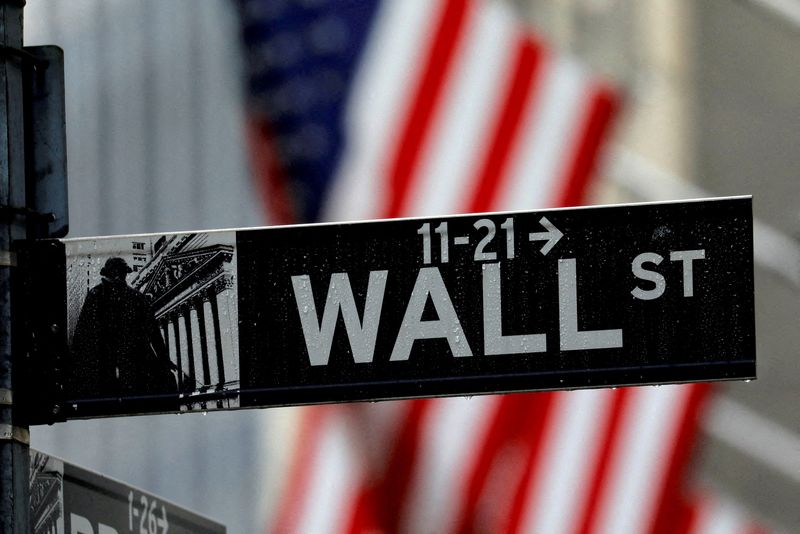Forex
Marketmind: Dollar rockets as Powell trumps AI


© Reuters. FILE PHOTO: Raindrops hang on a sign for Wall Street outside the New York Stock Exchange in Manhattan in New York City, New York, U.S., October 26, 2020. REUTERS/Mike Segar/File Photo
A look at the day ahead in U.S. and global markets from Mike Dolan
Hopes for a late August bloom in world markets were put on hold as investors hunkered down for a sobering assessment of the long-term interest rate trajectory from the Federal Reserve boss later on Friday – sending the dollar soaring again in the process.
Fed Chair Jerome Powell is due to deliver a keynote address to the annual central banking symposium in Jackson Hole at 1405 GMT. Trepidation about the speech largely explains why renewed buzz about artificial intelligence after this week’s blowout Nvidia (NASDAQ:) results ended up being such as a damp squib on Thursday.
And given increasingly contrasting fortunes of economies on either side of the Atlantic, Powell’s words are expected to contain a different message to the one from European Central Bank President Christine Lagarde later in the day at 1900 GMT.
That much was underlined by August business surveys this week showing activity contracting in the euro zone but still expanding stateside. Another survey miss from Germany’s Ifo on Friday reinforced the picture.
The euro/dollar exchange rate plunged to its lowest level in more than two months on Friday as a result – off a whopping 4.5% from the peaks of July as the U.S. long-term bond yields resumed their upward march through August.
The dollar’s index against the most traded currencies leaped to its highest since June 7, with sterling recoiling sharply too to June levels due to gathering UK economic clouds.
Spurring the dollar on ahead of the Jackson Hole set-piece was a marginal shift in Fed futures pricing to now indicate a greater than 50% chance of one more Fed rate hike to the 5.5-5.75% next month.
While not a sea change in pricing, the shifting odds put the onus on Powell to walk the market back if indeed he wants to signal the Fed is done with its rate hike campaign.
Some of his colleagues on Thursday indicated that the central bank may indeed have done enough on policy rate tightening – and can continue bear down on inflation by keeping rates high for longer. That allows the traditional lags in credit tightening to kick in while keeping long-term bond markets on their toes.
Philadelphia Fed President Patrick Harker and Boston Fed President Susan Collins tentatively welcomed the recent jump in bond market yields as something that could complement the Fed’s work to get inflation back to the 2% target and stave off another hike.
“We may be near, we could even be at a place where we would hold,” Collins said.
“Higher longer rates are consistent with an understanding that this is going to take some time,” said Harker.
Certainly the latest U.S. economic numbers showed no sign of unfolding weakness, with jobless claims falling below forecast in the latest week and core durable goods orders still resilient in July too.
Markets pricing for the ECB and Bank of England policy rates, meantime, has recoiled sharply in recent weeks. Money market and swaps rates now see the ECB campaign as over at 3.75% and no further hikes likely in the cycle. Implied BoE terminal rates have fall back sharply to 5.5% from as high as 6% in July.
That helped European stocks buck the dour equity market mood of the past 24 hours, where Asia shares had followed Wall St’s sharp tech-led reversal into the red on Thursday. U.S. futures were mostly flat ahead of the open on Friday.
Treasury yields were a shade higher overnight, while oil prices perked back up.
China’s bourses were also in the red but authorities are planning to cut the stamp duty on stock trading by as much as 50%, sources told Reuters – a further attempt to revitalise the country’s struggling stock market. Authorities also stepped up their defence of the yuan.
gave back only some of Thursday’s gains after its central bank shocked with a 750 basis point interest rate to 25%.
Events to watch for on Friday:
* Federal Reserve Chair Jerome Powell gives keynote speech at annual Fed symposium in Jackson Hole. European Central Bank President Christine Lagarde also speaks at Jackson Hole.
* University of Michigan’s final August consumer survey
* ASEAN finance ministers, central bank chiefs meet in Jakarta
* U.S. corporate earnings: Marvell (NASDAQ:), Workday (NASDAQ:), Hibbett etc
(By Mike Dolan, editing by Christina Fincher, mike.dolan@thomsonreuters.com. Twitter: @reutersMikeD)

 Forex3 years ago
Forex3 years agoForex Today: the dollar is gaining strength amid gloomy sentiment at the start of the Fed’s week

 Forex3 years ago
Forex3 years agoUnbiased review of Pocket Option broker

 Forex3 years ago
Forex3 years agoDollar to pound sterling exchange rate today: Pound plummeted to its lowest since 1985

 Forex3 years ago
Forex3 years agoHow is the Australian dollar doing today?

 Cryptocurrency3 years ago
Cryptocurrency3 years agoWhat happened in the crypto market – current events today

 World3 years ago
World3 years agoWhy are modern video games an art form?

 Commodities3 years ago
Commodities3 years agoCopper continues to fall in price on expectations of lower demand in China

 Economy3 years ago
Economy3 years agoCrude oil tankers double in price due to EU anti-Russian sanctions























